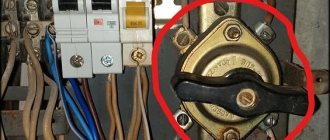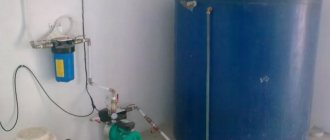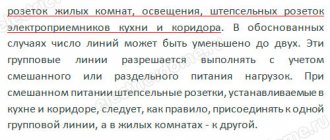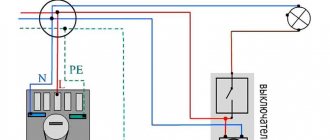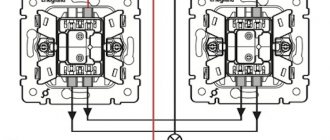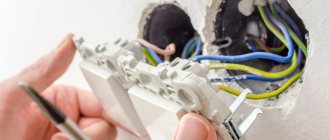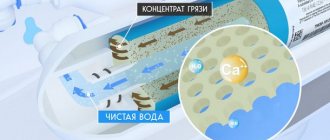RCD (residual current device) is designed to prevent dangerous effects on humans and animals of electric current when touching live and other parts of energized devices and electrical installations. The next important function of the device is to prevent fires when leakage currents appear on the ground. The protective effect is manifested by turning off the power supply in the following situations:
- short circuit of the body of an electrical appliance under voltage through the body to the ground;
- contact of current-carrying elements with grounded non-current-carrying parts of electrical installations as a result of insulation damage;
- change of grounding (PE) and neutral (N) conductors in the electrical circuit.
RCDs also protect networks from power surges. To do this, a nonlinear resistance is connected to the neutral at the input of the device and the phase at the output. The differential current flows through it when the voltage increases above 270 V, after which the RCD turns off.
Safety devices differ in types and operating principles. One of the most practical is a selective RCD, which provides targeted disconnection of groups of loads. Its feature is a reduced speed response characteristic (type S or G). It is installed closer to the source, has a residual trip current rating of 100 or 300 mA and ensures that the next conventional RCD located in front of the consumer will trip first.
Thus, modern protection of electrical networks is based on identifying faults and disconnecting individual sections from systems operating in normal modes.
How does the RCD work?
RCD is also called residual current switch. The purpose remains the same: to turn off the circuit when a current leak occurs. The main element of the device is a toroidal transformer with several turns of neutral and phase wires connected back to back. The resulting magnetic field during normal operation of the device remains equal to zero. A leak into the ground upsets the balance; a voltage arises in the secondary winding, upon reaching a certain value the electrical circuit is switched off using the starting and actuating mechanisms.
The RCD requires a PE grounding bus. Otherwise, when potential appears on the body of an electrical appliance due to damaged insulation, there is no current leakage, and if you touch it and grounded metal parts (heating radiator, water pipes), you can receive a noticeable electric shock. In this case, the protective device will work, but it will be better if it occurs from a leak into the ground.
For reliable operation of the protective device, grounding must be installed. When working according to this scheme, the RCD will break the circuit even before it touches the metal body of the equipment or household appliance.
Rarely used protection systems
- A directional system operates on the principle of current and voltage vector. There is always a phase shift between them. Protection devices analyze the difference and, if necessary, turn off equipment in the required sector.
- The differentiated system compares the deviations of parameters at the beginning of the supply line and directly at the unit. If deviations reach a specified value, the situation is considered an emergency. This selectivity is required if power is supplied to very powerful units.
Types of RCD
RCDs are classified according to the functions they perform:
- AC - response to a suddenly appearing or gradually increasing alternating leakage current.
- A - additionally triggered by a constant pulsating differential current, which can appear unexpectedly or increase gradually.
- B - response to direct and alternating pulsating leakage currents.
- S - selective RCD with additional time delay for shutdown.
- G - similar to S, but with less latency.
Where to install the RCD?
- Public places in buildings where there is no increased risk of electric shock.
- In electrical circuits with a possible risk of electric shock (rooms with humidity above normal, groups of sockets, household appliances, etc.).
- At the main entrance for protection against fire hazard. Usually a selective RCD is installed here.
- In floor distribution boards, in apartment panels, in individual houses.
- In radial power supply systems: general selective RCD and separate ones for outlet lines, with a choice of parameters that guarantee selective operation.
- At close protection levels, for example, 10 and 30 mA, 30 and 40 mA, etc., current selectivity of the RCD is unlikely due to the high response speed. For the indicated values, it is ensured if you select a 100mA selective RCD so that there is also a time delay.
- Due to aging of the insulation, there is not always a gradual increase in leakage currents.
- With an instantaneous increase in leakage current due to insulation breakdown, any conventional RCD located in series in the circuit can trip. This occurs due to the rapid and significant exceeding of settings at several stages of protection at once.
Varieties by rated current
The most popular are modular devices from the ABB and Schneider Electric brands. There are possible types of rated electricity, which indicates its value that can pass an infinite number of times through the device: 16, 25, 40, 63 A. Therefore, the choice of device should be based precisely on these values of rated electricity.
There is no device that could provide 100% protection against overcurrents (short circuit, network overload), and this must be understood. That is why it is important that all RCDs are supplied with a circuit breaker with a rated current of less or the same strength. This is what the rules say, but I consider it advisable to install the RCD and the machine in such a way that the device has a larger rated current.
I will try to explain such “violations” of the rules in more detail. It is known that the machine can transmit electricity from 1 norm to 1.13 for a very long time, and only for an hour - 1.13-1.45. So, for example, if both the machine and the RCD are 25 A, the device transmits electricity in the amount of 36 A (25 * 1.45) per hour. Most likely, the device will simply burn out.
The rated electricity value can be found on the front of the device.
Well-known brands produce devices with the ratings indicated above, but Chinese manufacturers can produce 32 or 50A RCDs.
The need to use selective RCDs
A selective RCD performs its fire protection function if modifications with a time delay are used - S or G. They are subject to increased requirements for resistance to short circuits, switching capacity, dynamic and thermal resistance, etc.
Typically, a selective fire protection RCD for high leakage current is installed at the main input.
RCDs cannot be used in circuits that cannot be switched off suddenly, as this can lead to emergency situations (fire or security alarms, danger to personnel, etc.).
In addition to RCDs, circuit breakers must have current selectivity. Overloads or short circuits located closer to the area should be triggered first. In this case, the circuit breakers operate before the short-circuit current reaches the limit value. This is necessary to prevent overloading of series-connected sections, since the current passes through the contacts of their protective devices.
Principle of operation
To understand how the protective structure performs its safety functions, you need to understand the operating principle of the RCD and the connection diagram. It has been established that the current from the network passes through the phase conductor through the load and then returns through the neutral wire. The operation of the device is based on this pattern.
Important! The operating principle of the RCD is based on comparing the values of the electric current at the output and input of the object, which is protected.
If Iin = Iout, then the device does not respond. As soon as Iin > Iout, the protective structure senses the leak and reacts as a result.
In other words, the currents passing through the phase and neutral wires must be the same (for a single-phase network). When the network is three-phase, then the value in the neutral is equal to the sum of the electric currents flowing in the phases. The inequality of electric currents indicates a leak, to which the device reacts.
When does an RCD not help?
However, you should not consider the RCD a panacea for any problems with electricity. The device is not smart enough to understand what exactly is included in the electrical circuit - a light bulb or a person. Shutdown will only occur if there is a leak.
The RCD does not protect against overvoltage, incl. from pulsed, as well as from low voltage, which “kills” electric motors - in a refrigerator, washing machine, and so on.
The unit also does not protect against short circuits. This task is performed by a circuit breaker or differential circuit breaker.
How many RCDs need to be installed?
To determine the exact number of RCDs required for a particular room, you will need a specialist who can carry out the appropriate calculations. For example, in a 1-room apartment, most likely, one such device, designed for a leakage current of 30 mA, will be enough. But in an apartment with four rooms and 15 groups of sockets, you will need at least five RCDs, as well as one device for the entire lighting group, electric stove and water heater.
It is usually assumed that one group of electrical appliances consists of one 30 mA residual current device plus one 100 or 300 mA fire protection RCD.
NOTE! To control the electrical wiring as a whole, it is recommended to install one general RCD with a rated breaking current of 300 mA at the entrance to a private house in addition to the calculated ones.
When is it not practical to install an RCD?
Sometimes there is simply no point in installing a device. One such situation is the presence of old and decrepit wiring. The ability of an RCD to detect a leak can become a headache if the device begins to operate unpredictably (which is what happens with poor wiring). In this case, the best solution would be to install the RCD not in the power supply circuit of the apartment as a whole, but in places with increased danger for using sockets.
There is also no point in buying a low-quality RCD. On the modern market you can find not only original devices, but also a wide range of fakes of unknown origin. Many of these devices are made “on the knee around the corner.” The use of such devices is completely unacceptable and inappropriate. Before purchasing, carefully study the technical documentation and quality certificates of the purchased unit.
It makes no sense to install the device in lines that supply voltage to stationary equipment and lamps, as well as in general electrical networks.
Types of selective RCDs
For a selective RCD, it is important to pause so that the general type device located lower in the circuit has time to operate. In this case, the device with a time delay shutdown allows leakage current to pass through itself and does not operate. The delay interval may vary between models. For products marked S, it is 0.15-0.5 s, for example, the RCD 63a 100mA is selective, with the ability to adjust the delay. The best choice will be if they are installed at the input of the apartment's power cable. Some foreign models have even higher time delays. They are designed to disconnect the circuit in the event of a fire hazard. The longer the protection is turned off, the greater the likelihood of the insulation igniting.
When marked G, the device operates within 0.06-0.08 s. The device is quite fast in responding to network problems. It should be installed below the S selective RCD. With two-stage protection, it can be installed at the main input, since the performance of the RCD connected below is still higher.
If there are several groups of loads in the network, a separate protective device is connected in front of each, and a selective fire protection RCD is connected to the input. Then, if one of the lines malfunctions, only that line will be de-energized, while the rest will remain connected. With such a connection diagram it is easier to detect a malfunction. If a conventional RCD turns out to be faulty or does not respond to problems in the circuit, then a selective RCD (300 mA or 100 mA) will trip and disconnect the entire network.
To ensure selectivity, the following instrument settings are required:
- set the response time of the selective RCD, if it provides such a possibility;
- set the required shutdown parameters depending on the magnitude of the leakage current.
The shutdown characteristics of selective RCDs must be at least 3 times higher than the others. Only in this case will the device be guaranteed to work.
Protection selectivity map
There are no ideal nutrition options. Different load conditions imply different emergency situations. It is the selectivity map that allows you to see the operation of relay protection virtually. By simulating the design on paper, engineers can ensure that the protection can operate correctly in all modes. Branched circuits are characterized by the presence of protective devices with different time-current characteristics. For example, let’s take any machine gun and define it as “our defense.”
We will call the remaining devices in the diagram adjacent. The main principle of proper organization is that the time-current characteristics of all devices should not intersect at the same linear level. If we draw a time line as a coordinate axis, then there should be a gap between the stages of selectivity. This can only be seen on charts. This is a selectivity map: it combines the characteristics of adjacent protections.
Information: For simple schemes for organizing selective protection, mapping is not required. If there are no adjacent levels, compatibility is not calculated.
To construct maps, it is better to use special computer programs. Although professional engineers easily draw graphs with a pencil. After building all the parametric curves, the graph is checked for their intersection. If such a situation arises, the criticality is checked: perhaps nothing needs to be changed. If the power lines are not dependent on each other, dividing does not change anything.
In other cases, it is necessary to ensure a time difference along the time axis of at least 0.25 seconds.
In addition, even if the response time selectivities intersect, dilution can be organized based on the difference in the cutoff current. As a rule, both methods are used; this can be taken into account when constructing a map, or it can be left at a practical level.
RCD parameters
Two time parameters of the RCD are determined by Russian standards:
- shutdown time - the interval from the appearance of the shutdown leakage current ∆i until the moment the arc is extinguished;
- the maximum non-operation time for a type S device is the time interval between the beginning of the occurrence of ∆i and the opening of the contacts.
The last parameter determines the selectivity of the RCD. Its limit value is 0.5 s. It should be taken into account that to protect people, opening should occur within 10-30 ms, to prevent insulation fire - up to 500 ms. Type S selective RCD is widely used where it is necessary to exclude false alarms from the influence of interference or voltage surges.
Based on the speed of disconnection, RCD networks are divided as follows:
- general use - without delay;
- type G - 10-40 ms;
- type S - 40-500 ms.
Leakage currents always occur in electrical circuits. In total, they should not be higher than 1/3 of the nominal ∆i of the device. It is believed that per 1 A of load there is 0.4 mA of consumer leakage current, and per 1 m of phase wire length - 10 μA. The protective device is adjusted according to the total natural leakage current. If this is not done, frequent false positives may occur. It should be taken into account that a device with ∆i=100 mA will no longer protect a person from electric shock.
When designing electrical networks, you may not indicate the type of RCD until experts require it. But you need to justify your choice in advance. It is important that the rated current of the device is higher than the current of the intended load. In addition, the RCD is installed only in a common pair with a circuit breaker. You can install one differential machine instead of two devices. It will cost less, but you need to choose the right parameters.
The RCD protects in two-wire networks where there is no protective conductor. But it only works after touching a dangerous place.
Safety Basics
Work is carried out in compliance with the following rules:
- The line is de-energized and checked for absence of voltage with an indicator screwdriver. If the switch is located far from the installation site of the RCD, you should attach a sign on it with the text “People are working!” or place a watchman. To be safe, it is recommended to disconnect the wires from the terminals.
- When connecting wires, use only methods approved by the PUE: clamps, terminals, crimping with sleeves, welding. Soldering is not recommended; twisting is prohibited.
- The correct installation is checked by measuring the resistance of the phase-zero loop. A high indicator indicates poor contact in one of the connections. During operation, such places become hot and can cause a fire.
- Before applying voltage, protect eyes and exposed parts of the body. A low-quality product may fly apart.
- Do not use wires with insulation of the same color.
Sources
- https://StrojDvor.ru/elektrosnabzhenie/princip-raboty-i-sxema-podklyucheniya-uzo-v-trexfaznoj-seti/
- https://electrik-ufa.ru/raznoe/printsip-raboty-uzo-v-odnofaznoj-seti
- https://odinelectric.ru/equipment/circuit-breaker/chto-takoe-uzo-naznachenie-markirivka-vidy
- https://dom-i-remont.info/posts/elektrika/nadezhnaya-elektrozashhita-seti-kak-rabotaet-uzo-s-zazemleniem-ili-bez-nego/
- https://www.asutpp.ru/kak-pravilno-podklyuchit-uzo.html
- https://ElectrikBlog.ru/kak-podklyuchit-uzo-pravilno-instruktsiya-na-7-skhem-s-foto/
- https://zen.yandex.ru/media/rmnt/kak-vybrat-i-pravilno-podkliuchit-uzo-5bd9504cb098ea00a9cc3e8d
- https://altenergiya.ru/poleznye-stati/sxemy-podklyucheniya-uzo-v-odnofaznoj-i-trexfaznoj-seti-varianty-montazha-i-pravila-bezopasnosti.html
- https://stroyhelper.ru/shema-podklyucheniya-uzo/
Which fire protection RCD should you choose?
Selective RCD 63A, 300mA is usually installed at the entrance as a fire protection device.
Many people use conventional general-type models, installing 30 mA protection devices in the house. Here the “partial” selectivity function is performed due to the large difference in operating currents. This saves money on price differences. In addition, a conventional RCD provides better safety due to faster response when catching leakage currents. The difference in the behavior of the devices is that the selective device will not turn off first when the differential current is equal to or greater than 300 mA. Such a situation is already extraordinary and there is no question about whether it is worth going to the control panel, which may be located on a street pole. With such a large current, a conventional RCD will probably work if there is an accident on the line. Here it will be clear where to look for the problem.
Thus, the fire protection RCD can be installed either selective or regular.
RCD manufacturers
The Legrand Group is a world-renowned manufacturer of building electrical systems. The leading position is ensured by the highest production culture and large investments in the creation of new electrical products. For Russia, the group supplies the entire range of electrical equipment, from sockets and switches to the most complex control systems.
Selective RCD Legrand is of electronic and electromechanical type (indicated on the front panel). Depending on the version, it is installed on the side or below the circuit breakers. The time delay (0-1.3 s) and sensitivity are adjustable. In combination with automatic machines they are used as highly sensitive or basic protective devices.
Prices for RCDs remain high, like other brands.
The ABB company most fully presents RCDs with the F 200 series - from 16 A to 125 A. For a home network, a 63A RCD, 100mA selective, is sufficient. For leakage currents, a 30 mA device is usually used for household appliances. As fire protection at the entrance to a private house, an ABB selective RCD (63A, 300mA) four-pole for a three-phase network is used, as one of the most reliable. The quality of Legrand brand products is not inferior to it. For an apartment with a single-phase input there will be a two-pole device. The photo below shows an ABB 63A, 300mA selective RCD.
The maximum current that the device can withstand is from 3 to 10 kA (indicated on the front panel). It is a short-term current, not an operating current. The RCD is able to withstand a pause until the machine turns off the circuit.
The company is one of the leading ones, but the prices are very high. Consumers often prefer ABB models because safety costs the most. ABB DDA200 AP-R type A and AC differential block is available. It has a trip delay of 10ms, although it is not an ABB selective RCD. Its tripping characteristic curve is located between selective and conventional RCDs. The device has increased resistance to false alarms compared to general-purpose devices.
The defect rate for the ABB selective RCD, as for other products, is only 2%, due to which there are practically no problems in operation. Electromechanical devices are much more reliable than electronic ones and have advantages in everything, except for the price. RCDs with an electronic actuator are already beginning to appear, which are not inferior in reliability to mechanical ones.
On the market you can find products half the price, but the quality is not inferior to ABB. The company also produces the FH 200 series, which has a slightly lower price, but is significantly inferior in quality to the F 200 products. In particular, it does not have such reliable conductor fastening contacts, which quickly begin to loosen, which affects the quality of work.
If you purchase an ABB selective RCD, then only in specialized stores, and not in dubious places. A counterfeit is dangerous because it is not able to protect a person properly. DIYers pay great attention to modular equipment, the list of which also includes RCDs, due to their high cost.
The domestic group of companies IEK produces about 7 thousand types of products that meet international standards and ensure reliable operation of electrical networks.
High demands are placed on RCDs. On the one hand, they must operate reliably, protecting people from electric shock and wiring from the danger of fire. But at the same time, devices installed at different stages of electrical circuits must act selectively, turning off individual sections. These conditions, as well as GOST 51326.1, correspond to the selective RCD IEK type VD1 63S.
The product group is represented by rated currents of 25-80 A, and differential currents of 100 mA and 300 mA. The products are cheaper than those of famous brands and are widely used as introductory fire-fighting apparatus. In this case, the selectivity of protection is ensured by large values of cut-off currents and time delays for disconnecting circuits.
Selection of protective devices
If electricity is consumed according to a simple circuit, a sinusoidal current flows through the circuit. The leak will have a similar shape and AC type devices can be used here.
Modern household appliances increasingly use phase-cut control circuits. An AC type device will not respond to them and here it is better to use a type A RCD, which also responds to sinusoidal current. The devices can be used together, for example, type AC is suitable for lighting with incandescent lamps, and type A is suitable for sockets to which devices with pulse control can be connected. But if you have to change the lighting to energy-saving lamps with brightness control by phase cutoff, you will also have to replace the device type AC with A. Otherwise it will not work.
In order to separate the operation by levels of electrical circuits, it is necessary to use selective devices. Type S is installed on the main input, type G on the second level, and then instantaneous devices.
The RCD is selected one step higher in rated current than the circuit breaker connected in pair with it, which can operate for a long time when the load is exceeded. If there is a 50 A circuit breaker at the input, a 63A selective RCD will be suitable for it.
According to the requirements of the standards, the nominal values of voltage, as well as continuous and breaking current ∆i are indicated on the front panels of devices. If there is a sinusoid designation, this is an AC type. The presence of two positive half-cycles under it means type A. Selective RCDs are designated by the letters S and G. The rated short-circuit current is indicated in the frame. The device must withstand its increase to the maximum until the machine turns off. Usually the current does not have time to reach the limit value. The RCD disconnects the circuit with a defect in advance, before the conductor heats up and the insulation ignites.
